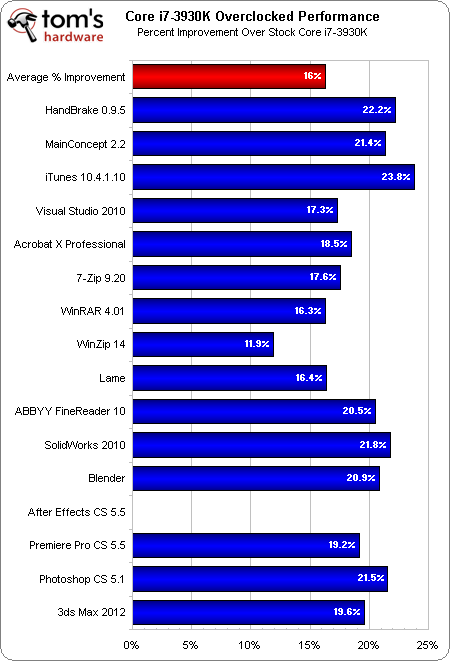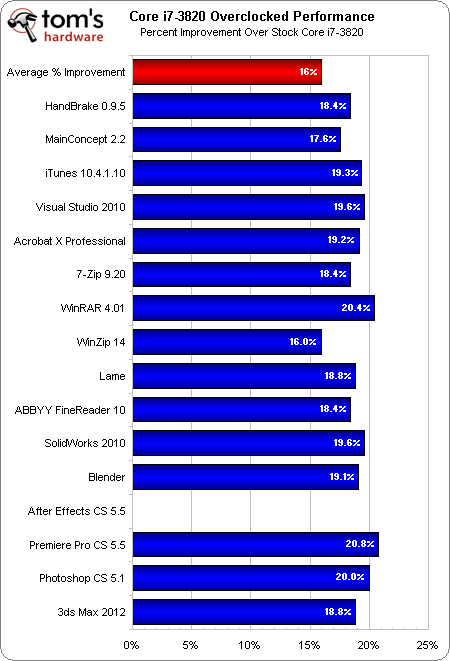Intel Core i7-3930K And Core i7-3820: Sandy Bridge-E, Cheaper
Core i7-3960X is undeniably fast. But at more than $1000, it’s hardly an option for most enthusiasts. We got our hands on the Core i7-3930K and Core i7-3820 to gauge their overclocked performance and determine if they’re able to best the flagship part.
Core i7-3930K And -3820: Stock Versus Overclocked
On average, overclocking Intel’s Core i7-3930K in 16 different applications results in a 16% speed-up. But that’s including After Effects, which suffers a horrible -27.8% slow-down due to our decision to shift from 32 GB of DDR3 memory down to 8 GB. Factor that out, and the average springs up to 19%.
The -3820 also picks up 16% with After Effects considered, and 19% with the memory-hungry app disqualified. Unfortunately, getting there on our M0-stepping processor required some nasty voltage settings, and even then, DiRT 3 and World of Warcraft exhibited periodic stability issues that kept us from collecting benchmark results. Stepping down to 4.5 or 4.375 GHz using the 125 MHz strap didn’t help, either.
Although the Core i7-3820 does enjoy its high points against Gulftown and the Sandy Bridge-based Core i7-2600K, its pricey platform, locked multiplier, and quad-channel memory requirement don’t seem to deliver any more value than a Core i7-2600K on an inexpensive Z68-based board—and that platform gets you Quick Sync support.
Get Tom's Hardware's best news and in-depth reviews, straight to your inbox.
Current page: Core i7-3930K And -3820: Stock Versus Overclocked
Prev Page Benchmark Results: World Of Warcraft Next Page Core i7-3930K and -2600K: Making The Tough Choice-
compton This is a really excellent analysis. Clearly, I must be drinking at the wrong places because I never leave the pub with any hardware nicer than a hangover.Reply -
theuniquegamer So nice overclocking at 4.5ghz. I can expect that the upcoming ivy bridge unlocked series may be stable atleast 4.2 will all 4 cores active. I can't wait till Q2 next year to see benchmarks .Reply -
Dacatak Possible TYPO in the bottom graph for Dirt 3 benchmark.Reply
FX-8150 benchmark with no AA says "68.8" FPS. I think it's more like "48.8". -
JOSHSKORN For gaming (the high end CPU intensive), is there any noticeable difference between the 2500k and the 3960X?Reply -
Dacatak JOSHSKORNFor gaming (the high end CPU intensive), is there any noticeable difference between the 2500k and the 3960X?Reply
If by "noticeable" you mean "perceivable to mere mortals", then no.
If you can in fact notice the difference between 105 vs 110 FPS, then you are a god, and you deserve only the best. -
spunkyddog I bought the i7-3930K with 32GB of DDR3 1600 RAM last week and assembled a couple days ago. I have two Kingston 120GB SSDs in RAID that have been benched on my system at a theoretical 1,100MB/S Read and 1,300MB/S Write. Coming from a Pentium D 3.0GHz, this was like night and day. My renders went from 40minutes to 1minute. I'm not overclocking purely for the fact that this thing's a beast already and I'm doing high-end 3D work using Maya, Photoshop, After Effects, Video, etc. Also - I like the peace and quiet.Reply
Intel did an awesome job with the SBE line - despite the fact that we're missing some wanted/promised features (native support for USB and PCI-Express 3.0. I'm waiting out for the PCI 3.0 cards before I upgrade my graphics... curious if the Asus P9X79 Pro will hold it's promises.
Thanks Chris for reviewing this processor. I felt like I went out on a limb getting this processor over the Extreme, but the $600 was well worth it. -
cangelini spunky,Reply
Glad you're enjoying. You do, actually get PCIe 3.0 support, but no USB 3.0, unfortunately.
Dacatak,
Yup, typo--fixing now! -
sna the only good reason to get X79 is the more ram .. u can get cheap 32G ram system , or go for 64G of ram and enjoy a ram diskReply
it is a good thing -
soccerdocks The Overclocking Sandy Bridge-E On A Budget page states, "With all of that said, 4.5 GHz was rock-solid down at 3.61 V". I'm pretty sure you meant 1.36 V.Reply -
cangelini soccerdocksThe Overclocking Sandy Bridge-E On A Budget page states, "With all of that said, 4.5 GHz was rock-solid down at 3.61 V". I'm pretty sure you meant 1.36 V.Reply
Indeed, fixed! At 3.6 V, we'd have dead Sandy. :)


